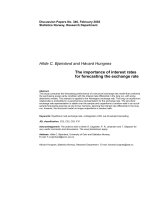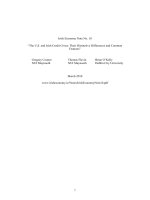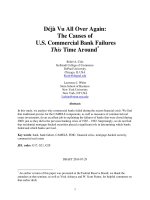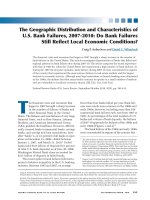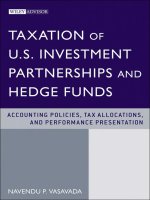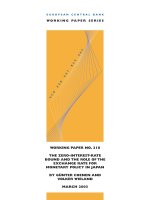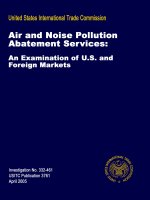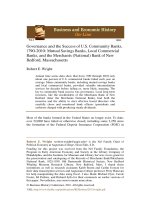The Exchange Rate Exposure of U.S. and Japanese Banking Institutions potx
Bạn đang xem bản rút gọn của tài liệu. Xem và tải ngay bản đầy đủ của tài liệu tại đây (275.11 KB, 37 trang )
Financial
Institutions
Center
The Exchange Rate Exposure of
U.S. and Japanese Banking
Institutions
by
Sandra Chamberlain
John S. Howe
Helen Popper
96-55
THE WHARTON FINANCIAL INSTITUTIONS CENTER
The Wharton Financial Institutions Center provides a multi-disciplinary research approach to
the problems and opportunities facing the financial services industry in its search for
competitive excellence. The Center's research focuses on the issues related to managing risk
at the firm level as well as ways to improve productivity and performance.
The Center fosters the development of a community of faculty, visiting scholars and Ph.D.
candidates whose research interests complement and support the mission of the Center. The
Center works closely with industry executives and practitioners to ensure that its research is
informed by the operating realities and competitive demands facing industry participants as
they pursue competitive excellence.
Copies of the working papers summarized here are available from the Center. If you would
like to learn more about the Center or become a member of our research community, please
let us know of your interest.
Anthony M. Santomero
Director
The Working Paper Series is made possible by a generous
grant from the Alfred P. Sloan Foundation
Sandra Chamberlain is at the Department of Accounting, Santa Clara University. John S. Howe is at the
Department of Finance, University of Missouri, Columbia. Helen Popper is at the Department of Economics,
Santa Clara University.
This paper was presented at the Wharton Financial Institutions Center's conference on Risk Management in
Banking, October 13-15, 1996.
The Exchange Rate Exposure of U.S. and Japanese Banking Institutions
1
First Version: July 1996
Abstract: In this paper, we examine the foreign exchange exposure of a sample of U. S.
and Japanese banking firms. Using daily data, we construct estimates of the exchange rate
sensitivity of the equity returns of the U.S. bank holding companies and compare them to
those of the Japanese banks. We find that the stock returns of a significant fraction of the
U. S. companies move with the exchange rate, while few of the Japanese returns that we
observe do so. We next examine more closely the sensitivity of the U.S. firms by linking
the U.S. estimates cross-sectionally to accounting-based measures of currency risk. We
suggest that the sensitivity estimates can provide a benchmark for assessing the adequacy
of existing accounting measures of currency risk. Benchmarked in this way, the reported
measures that we examine appear to provide a significant, though only partial, picture of
the exchange rate exposure of U. S. banking institutions. The cross-sectional evidence is
also consistent with the use of foreign exchange contracts for the purpose of hedging.
JEL Classification: F31, F23, G21, G28
Keywords: Foreign Exchange Risk, Banking, Market Risk
The Exchange Rate Exposure of U. S. and Japanese Banking Institutions’
1.
Introduction
This paper studies the exchange rate exposure of firms in the banking industry. Like many
firms, banks can be affected by exchange rate fluctuations. Exchange rates affect most directly
those banks with foreign currency transactions and foreign operations. Even without such
activities, exchange rates can affect banks indirectly through their influence on the extent of foreign
competition, the demand for loans, and other aspects of banking conditions. The purpose of this
paper is to examine the size and significance of the exchange rate exposure in the banking industry
and to investigate its relationship to various accounting measures of risk. To that end, we first
estimate the exchange rate sensitivity of the equity returns of a sample of U. S. bank holding
companies. We then compare the U. S. estimates to similar estimates that we construct for
Japanese banks. We find that the stock returns of a significant fraction of the U.S. banking firms
move with the exchange rate, while few of the Japanese returns that we observe do so. We next
examine more closely the exchange rate sensitivity of U. S. banking firms by linking the U. S.
estimates cross-sectionally to accounting indicators of foreign exchange exposure.
While the exchange rate can influence the value of firms in many industries, our focus on
banks stems in part from the growing international interest in monitoring banks’ market risks,
including foreign exchange risk. Through the aegis of the Basle Committee on Banking
Supervision, central bankers from Europe, Japan, and North America in 1993 proposed uniform
a. The authors thank the Federal Reserve Bank of San Francisco and Ernst and Young of San Jose for research
support. We also thank Elizabeth Laderman and Mark Levonian for their thoughtful comments. Finally, we
are grateful to Barbara Rizzi of the Federal Reserve Bank of San Francisco for her thorough and conscientious
research assistance.
1
measures of various types of market risk.
1
According to the proposal, foreign exchange risk
would be measured by tallying up net open positions across currencies, including positions arising
both from foreign assets and liabilities, and from off-balance sheet instruments.
More recently, the central bankers altered the proposal and agreed to implement it by the
end of 1997. The alteration gives banks the choice of assessing their exposure either through the
building block approach or through their own internal risk management tools. This added
flexibility is potentially very important because the building block approach by itself can provide
only a narrow measure of a bank’s exchange rate sensitivity. The building block approach
uniformly treats foreign exchange holdings as if they add to currency risk; but if a bank chooses
its currency holdings to offset the exposure arising from its other activities, such a treatment is
inappropriate. In that case, the bank’s holdings reduce, rather than increase, its risk. By giving
banks broader scope in assessing their own exposure, the Committee enables them to incorporate
the links between their foreign exchange holdings and their other activities. In this paper, we also
take a broad view of foreign exchange risk: we gauge the exchange rate exposure of banks in
terms of the sensitivity of the bank’s total value to changes in the exchange rate. This allows us
to appropriately incorporate the covariances among all of the activities of the bank into a gauge of
its overall exchange rate exposure.
By focusing on firm value, our work follows in the tradition of Adler and Dumas (1980),
who define exchange rate exposure in terms of a regression of asset value on the exchange rate.
Our work also builds closely on more recent studies of the market risks faced by banks. Most
1. The Basle Committee originally established international risk-based capital standards in its 1988 Accord. The
proposal described here was adopted in 1995 as an amendment to the Accord. It broadens the scope of the Accord to
reflect banks’ exposure to fluctuations in market prices, such as interest rates, securities prices, and exchange rates.
2
such studies
including Flannery and James (1984), Chen and Chan (1989), Mitchell (1989), and
Collins and Venkatachalam (1996) have focused on banks’ interest rate exposure. Several
other studies have explored the exchange rate exposure of nonbank firms, but we are aware of
only one by Choi, Elyasiani and Kopecky ( 1992) that examines the exchange rate exposure of
banks.
2
Choi, Elyasiani and Kopecky find evidence of foreign exchange exposure when they
aggregate bank returns. However, their aggregation precludes them from linking the estimated
exchange rate exposure to individual firm characteristics.
Our paper contributes to this literature in three ways. First, we are able to discern
exchange rate exposure among individual U.S. bank holding companies. This evidence of
exposure at the individual firm level contrasts with earlier studies of both bank and nonbank firms.
We attribute our new findings to the use of daily data, which increases the power of our tests
vis-à-vis the use of monthly data. Second, we link our estimates from the daily data to
cross-sectional data collected from required bank holding company reports. Some authors, such
as Collins and Venkatachalam, have linked cross-sectional data to interest rate risk, but the links
to exchange rate risk remain largely unexplored. Our results provide some insight both into the
usefulness of accounting indicators of exposure and into the currency risk management practices
of large U.S. banks. Finally, we estimate the exchange rate exposure for Japanese banks, and we
compare it to U.S. exposure. While we are unable to examine the accounting disclosures of
Japanese banks, the comparison nevertheless provides a necessary first step to understanding
international differences in foreign exchange exposure.
2. Some nonbank studies include: Adler and Dumas (1980), Jorion (1990), Bodnar and Gentry (1 993), and Bartov and
Bodnar (1994).
3
To examine exchange rate exposure and its link to existing accounting indicators, we first
estimate the sensitivity of equity returns to changes in the exchange rate. Section 2 describes this
step in detail. The subsequent sections discuss the relationship between the measure of overall
foreign exchange exposure and available accounting indicators. Section 3 provides a discussion
of some important data considerations. Section 4 presents the cross-sectional analysis, and the
final section concludes.
2.
Estimation of Foreign Exchange Exposure
We estimate the sensitivity of returns to the exchange rate in the context of an augmented
market model. While we suggest that the exchange rate may be a significant factor in determining
bank returns, we use an augmented market model because the exchange rate is not the only
factor, or even necessarily the most important one. We would be unlikely to get a good estimate
of a firm’s exchange rate sensitivity by estimating it in an equation that leaves unexplained the
preponderance of the variability in the return. Following Jorion and others, we include the market
return in the estimating equations. We also extend the estimating equation to include a bank
portfolio return. This provides some control for other industry-wide sources of variation in
returns, such as interest rate changes.
3
Specifically, we regress the return of each bank or bank
holding company, r
i
, on a market return, r
m
, on a portfolio of bank returns, r
b
, and on the
appreciation of the exchange rate, s. We measure the exchange rate exposure of the i* banking
3
To verify that our results are not an artifact of our inclusion of that portfolio return, we also estimate the equation
without the bank portfolio. The results we report here are little changed by the alternative specification.
4
(1)
terms of the domestic currency, a banking firm with a net long foreign currency position (inclusive
of both its portfolio of foreign exchange instruments and the position implicit in its other
We estimate the equation at both daily and monthly frequencies, and the returns and the
exchange rate appreciation are correspondingly defined. In constructing the U. S. sample, we
began with the largest 100 U.S. bank holding companies, as measured by asset size and reported
by
American Banker (1993).
We then narrowed the sample to include only those banking firms
that were traded over the entire sample period on the NYSE or the AMEX and for which we
were able to obtain Y-9 reports. This procedure yielded a sample of thirty bank holding
companies. We restrict our initial group of firms to large U.S. banking firms for three reasons.
First, the largest firms are arguably the most likely to have substantial international activities.
Second, they are closer to being comparable in size to the most active international banks of other
industrialized countries.
4
Finally, they are likely to be perceived as potentially important
contributors to systemic risk and hence worthy of greater regulatory scrutiny. Appendix A
provides a list of the bank holding companies included in the sample. Both the daily and the
4
U.S. banks are typically much smaller than the banks of other major industrialized countries. For example,
according to American Banker’s 1993 asset rankings, the largest U.S. bank (Citibank) is only the thirtieth in size
internationally.
5
monthly stock returns of these companies are compiled from CRSP files.
For the Japanese bank sample, we include monthly observations of the largest 110 Japanese
banks, also as measured in terms of assets size.
5
These banks are listed in Appendix B. Monthly
Japanese stock returns are taken from WorldScope data.
6
Daily Japanese bank returns are taken
from Extel Research data, and the complete daily sample includes 89 Japanese banks.
As gauges of the market return, r
m
, we use the CRSP value-weighted index for the United
States and the Nikkei 225 index, obtained from DRI, for Japan. We obtain the banking industry
return, r
b
, from the NYSE financial index for the United States and the Nikkei’s bank index for
Japan, as reported by DRI.
In choosing the appropriate exchange rate appreciation measure, s
t
, three issues arise:
whether to measure the exchange rate in real or nominal terms, how to choose among the many
bilateral and multilateral exchange rates, and how to distinguish between its anticipated and
unanticipated components.’
With regard to the distinction between real and nominal exchange
rates, we note that while the distinction may matter in principle, there is little difference between
the two in practice because they are extremely highly correlated. Moreover, real exchange rate
data are unavailable at the daily frequency. So, we estimate Equation 1 using nominal exchange
rates only. With regard to choosing among the many bilateral and multilateral exchange rates, we
first estimate the equation using trade-weighted foreign exchange rates, then were-estimate it
5
These are all of the Japanese banks included in
American Banker’s “The
Top 500 Banks in the World.”
6
Because WorldScope does not report ex-dividend dates, the Japanese monthly returns do not included dividends,
However, the average annual dividend yield for the included firms is less than 1 percent. So, the omission is of little
consequence. The daily Japanese returns include dividends.
7
A bank’s sensitivity to the two might be different. For example, one might argue that it is easier to hedge open
nominal exchange rate positions than to assess and hedge the exposure associated with real exchange rates.
6
with several other of the major bilateral rates. The findings are qualitatively robust to these
alternative specifications, so we focus the discussion on the estimates found using the trade-
weighted foreign exchange rate measure.
The third issue, distinguishing between unanticipated and anticipated exchange rate changes,
arises from the empirical framework provided by the augmented market model. The model calls
for using
unanticipated
changes in the exchange rate.
Expected
changes over each period should
not affect returns, since they should be reflected already in the stock price. We rely on the robust
finding of Meese and Rogoff (1983) that the current exchange rate outperforms standard
exchange rate models in predicting the future exchange rate.
8
That is, actual exchange rate
changes are largely unpredictable. So, we use the actual changes as an indicator of the
unanticipated changes. All exchange rate measures are obtained from DRI.
Table 1 summarizes the results of the estimation. The table provides statistics that describe
median estimates and the standard deviation of the estimates, some aspects of its range, and the
number of firms whose exposure is found to be statistically significant.
The first two columns present the results for the monthly and daily estimates for the U.S.
bank holding companies, and the last two columns present the results for the Japanese firms.
For the U.S. firms, the exposure measures range from -0.12 to 0.28 at the monthly frequency, and
8
Meese (1990) reviews additional supporting evidence, and Chinn and
Meese (
1995) reaffirm the robustness of this
finding for horizons less than two years.
7
-0.07 to 0.20 at the daily frequency, and about two-thirds of the point estimates are positive. The
range of estimates for the Japanese firms is even greater:
-0.96 to 0.65 at the monthly frequency,
and -0.18 to 0.33 at the daily frequency.
The table also presents the number of firms in each sample for which we can reject at the
5 percent and 10 percent significance levels the null hypothesis that the coefficient on the
exchange rate is zero.
9
As the table shows, the number of such firms rises in all cases as we move
from monthly to daily data. In addition, the fraction of such firms is always greater in the U.S.
sample than in the Japanese sample. Consider the estimates from the monthly data first. At the
5 percent level, we can reject the hypothesis that the coefficient is zero for five of the U.S. firms
and for eight of the Japanese firms. This represents about 17 percent of the U. S. sample and
about 7 percent of the Japanese sample. At the 10 percent level, the numbers rise to nine U.S.
firms and ten Japanese firms, representing 30 percent of the U.S. firms and only about 9 percent
of the Japanese firms.
At the daily frequency, the number of banking firms for which we can reject the hypothesis
This represents 30 percent of the U.S. firms, but only about 10 percent of the Japanese firms. At
the 10 percent level, we are able to reject the hypothesis for eleven U. S. firms and for sixteen
Japanese firms, representing about 37 percent of the U.S. sample and about 18 percent of the
Japanese sample.
The finding that Japanese banks less frequently exhibit sensitivity to exchange rates than do
U.S. banks could bean artifact of our sample selection procedure. Specifically, the U.S. sample is
9
White-adjusted standard errors are used in these tests.
8
weighted more heavily by money center and dealer banks than is the Japanese sample; nearly one-
third of the U.S. sample is made up of money center banks, whereas only about one-fifth of the
Japanese banks would be characterized as money center institutions. To alleviate concerns about
this, we calculate the percentage of significant exchange rate parameters for nineteen major city,
trust, and long-term credit banks in Japan identified by Campbell and Hamao [1993] .10 Among
this more focused sample of banks, 21 percent (four banks) have exchange rate parameters that
differ significantly from zero at the 10 percent level. This is only slightly higher than the
18 percent found in the full sample. In contrast, 88 percent (seven out of the eight included in the
sample) of the U. S. money center banks have significant coefficients at the 10 percent level.
Thus, we do not attribute the difference in the findings to the sample selection procedure. Instead
we suggest that it arises from fundamental differences in the operations of the firms in the two
countries. These differences may reflect a number of factors, such as differences in the structure
of ownership, in securities and derivatives laws, in supervision, in the extent of foreign ownership,
or in hedging policies. Of particular note is the fact that Japanese banks typically have a much
larger share of foreign assets than do U.S. institutions.
11
Since the foreign currency positions of the banks could change from year to year, we might
expect exposure parameters to change by year. So, we re-estimate Equation 1 year by year.
Unfortunately, splitting the sample into five parts raises the standard errors substantially. As
10
These include Asahi Bank, Bank of Tokyo, Dai-Ici Kangyo Bank, Daiwa Bank, Fuji Bank, Hokkaido-Takushoku
Bank, Industrial Bank of Japan, Long-Term Credit bank of Japan, Mitsubishi Bank, Mitsubishi Trust and Banking,
Mitsui Trust Bank, Nippon Credit Bank, Sakura Bank, Sanwa Bank, Sumitomo Trust and Banking, Tokai Bank, Toyo
Trust Bank. and Yasuda Trust Bank.
11
According to Zenginkyo (1995), approximately 15 percent to 20 percent of Japanese assets were held in the form
of overseas assets during the period we examine.
9
would be expected, the number of firms for which we can reject the hypothesis that the exchange
rate coefficient is zero falls dramatically. The results of this exercise are summarized in
Appendix C.
Past studies have often failed to reject the hypothesis that the exchange rate coefficient is
zero. In trying to interpret the past failures to reject at the individual firm level, it has sometimes
been suggested that the exchange rate coefficient appears indistinguishable from zero because
firms largely hedge their exchange rate exposure. The findings presented here are less indicative
of complete hedging. Instead, they lend some support an alternative explanation, namely, that
some of the failures to reject have come from tests with low power. Moving from monthly to
daily data made it easier to discern firm level exchange rate exposure.
12
The use of higher
frequency data might also be well-suited to similar studies of other types of firms.
3.
Measures of the Determinants of Foreign Exchange Exposure
There are many potential sources of foreign exchange exposure. The most obvious source
of currency risk comes from having assets or liabilities with net payment streams denominated in a
foreign currency .13
This explicit source of currency risk is the easiest to identify, and it is the
12
Using
monthly data, Choi, Elyasiani, and
Kopecky
were unable to reject the hypothesis that the exchange
rate coefficients were zero for individual banks. However, they were able to reject it by combining the banks
and restricting the coefficients to be the same. We confirm their finding.
We
estimated a variant of Equation 1
(replacing the portfolio of bank returns with the treasury bill rate) and obtain an estimate of the exchange rate
of exposure of 0.049, with a standard error of 0.014, which is significant at all conventional confidence levels.
While this imposes the unappealing assumption that exchange rate exposure is the same across all the banks, it
additional support for the notion that it is a lack of power that leads to the failure to reject no exchange rate
exposure.
13
Fr example, a U.S. bank may own, say, a yen-denominated bond, with payments to be made in yen. A nominal
appreciation of the dollar against the yen would decrease the dollar value of that asset. If the bank has no offsetting yen-
denominated obligations (such as yen-dollar currency swap, or interest payments on yen deposits), then the dollar value
of its portfolio will rise or fall when the exchange rate changes.
10
most easily hedged.
14
Other sources of currency risk are more subtle but just as important. A
bank without any foreign assets or liabilities can be exposed to currency risk because the
exchange rate can affect the profitability of its domestic banking operations. For a simple
example, consider the value of a bank’s loan to an exporter. Since the exchange rate can affect
the exporter’s profitability, it can affect the probability of loan default and, correspondingly, the
value of the loan and the profitability of the bank.
15
The estimates of exchange rate exposure
provided in Section 2 implicitly treat all sources of exposure the same. In this section, we discuss
some of the explicit sources of exposure
those that can be discerned from accounting data. In
Section 4, we examine how these potential sources of exposure are linked to the estimated overall
exposure of each banking institution.
This study uses the data contained in U.S. bank holding companies’ regulaton financial
statements, known as Y-9 reports, to form accounting indicators of exposure. The Y-9 reports
are prepared according to regulatory accounting rules that are mostly consistent with those used
to generate annual reports for shareholders, known as Generally Accepted Accounting Principles
(GAAP). The Y-9 reports are particularly useful because they disclose the assets and liabilities
from foreign countries, items that are not disclosed under GAAP.
16
In terms of balance sheet
14
Payment streams in the major currencies can be converted into domestic currency using currency swaps, for
example.
15
If the dollar appreciates, it might become more difficult for the domestic (U.S.) firm to compete against foreign
firms. A stronger dollar then would imply a higher probability of default by the U.S. firm. The bank consequently
would suffer from a dollar appreciation. In this case, the bank is exposed to currency risk: it essentially is “short” dollars
against foreign currency.
16
Some authors such as Jorion [1990] have relied on disclosures in annual reports to shareholders. Under
GAAP’s Financial Accounting Standard (FAS) 14, annual reports to shareholders provide footnotes that include
geographic breakdowns of assets, revenues and a profit measure.
11
items, a bank holding company’s Y-9 provides the dollar value of important categories of foreign
assets and liabilities. The foreign assets reported include foreign debt securities, foreign equity
securities, and foreign commercial loans. The liabilities include interest bearing and non-interest
bearing deposits held in foreign offices. While the foreign assets and liabilities are not necessarily
denominated in foreign currencies, they nevertheless provide a measure of foreign activity a
potential source of currency risk. In examining the link between foreign activity and exchange
rate exposure, we use the difference between the reported foreign assets and foreign liabilities,
which we call Net.
17
Since 1990, the Y-9 reports also have provided some data on the extent of off-balance sheet
foreign exchange activity, which also can be linked directly to foreign exchange exposure.
18
In
our sample period, the off-balance sheet disclosures include the notional value of all foreign
exchange contracts held by the institution and the market value of those contracts, when the
market value is positive. As pointed out by Gorton and Rosen (1995) these data truncate the true
market values, which could be either positive or negative. Gorton and Rosen also point out that
there is no clear relationship between the market value and the notional value.
19
Rather than
relying directly on either the truncated market value or the notional value, we construct a dummy
17
Note that Net is not a complete measure of the bank holding company’s net foreign assets and liabilities.
Perhaps most importantly, it does not include foreign loans other than commercial loans.
18
The 1990 disclosures came about because of the imposition of risk-based capital standards. The intent of the
disclosures was to provide bank regulators with a measure of credit risk (i.e., the risk of a counter party failing to
perform) as opposed to market risk (i.e., risk due to changes in market prices such as exchange rates).
19
FAS 107, which has been updated by FAS 119, was adopted as GAAP in 1993 and requires all firms to provide
disclosures on the market value of financial assets and liabilities, and on off-balance sheet disclosures. In principal,
these disclosures might be used to form better measures of off-balance sheet activities with respect to hedging or
speculating in foreign currencies than those provided by the Y-9 reports. This is essentially the tactic taken by Collins
and Venkatachalam (1996) in their analysis of interest rate risk in banks.
12
variable that indicates whether such contracts are used at all. Then, we estimate the relationship
between foreign exchange exposure and the dummy variable. The notion that such contracts are
risky that is, they are used primarily to speculate
would imply that the relationship between
exposure and the use of contracts would be positive. In contrast, if the contracts are used to
hedge, then their use should be negatively related to exposure.
20
The Y-9 report provides two other items that might give a partial indication of a firm’s
foreign exchange exposure: the cumulative foreign currency translation and foreign loans
charged-off. The foreign currency translation reflects the conversion to dollars of the value of
assets and liabilities of a foreign business unit.
21
Examining the link between foreign loan
charge-offs and foreign exchange exposure gives an indication of the importance of foreign credit
risk in that exposure.
Table 2 and Figures 1 through 4 summarize the Y-9 data by year for the sample of U. S.
bank holding companies from 1986 to 1992. As shown in the top panel of Figure 1 and in
Table 2, these institutions substantially decreased their foreign commercial lending and their
foreign deposits during the sample period. As a fraction of total assets, their median foreign
commercial lending fell from almost 2 percent in 1986 to about ½ percent in 1992, and their
median foreign deposits as a fraction of total assets declined from about 3 percent to about
20
That is, a positive estimated parameter would be negatively related to the dummy variable if contracts were used
for hedging, and it would be positively related to the dummy if contracts were used for speculation.
21
The foreign currency translation rules fall under FAS 52. If a company has a business unit whose functional
currency differs from the dollar, then the company must measure each period the value of the assets and liabilities
associated with that business unit in dollars. This gives rise to a gain or loss which is added to the cumulative foreign
currency translation balance, which adjusts shareholder equity, but not income. When the company sells such assets
and liabilities, the gain or loss then becomes a part of net income. In addition, revenues and expenses denominated in
foreign currencies are also translated to dollars, effectively recognizing a gain or loss in current income. Bank Y-9
reports do not separately break out the income effects of FAS 52, only the balance sheet effects.
13
1½ percent. Meanwhile, they nearly doubled the percentage of their assets held in foreign debt
and equity securities.
The bottom panel of Figure 1 shows the behavior of Net, the sum of foreign commercial
loans and foreign debt and equity securities less foreign deposits. As shown, Net tends to be
negative for the sample of bank holding companies, and it was the most negative (-2½ percent of
assets) in 1988; it moved somewhat closer to zero during 1989 to 1992. To the extent that
foreign assets and liabilities are denominated in foreign currency, a negative value of Net indicates
a short foreign currency (long dollar) position. In the absence of complete hedging, such a
position would suggest that these banking firms as a whole would suffer translation losses with a
weakening dollar. This short foreign currency position, by itself also would suggest that these
firms typically would have positive foreign exchange exposure parameters. The bottom panel of
Figure 2 shows the mean foreign currency translation of these firms. Foreign currency translation
became more negative with each year, a trend that accords with the general weakening of the
dollar over this period. Table 2 also reports foreign charge-offs and foreign exchange contracts.
Foreign charge-offs peaked in 1990, then fell substantially. The market value of foreign exchange
contracts is only available for the period since 1990. Since then, it has averaged around 3 percent
of assets.
22
Table 2 and Figure 2 report the income and expense data that we were able to recover from
the Y-9 database. Since these income statement data are less inclusive than the balance sheet data
provided on the Y-9 reports, our cross-sectional tests emphasize the balance sheet data.
22
However, recall that market values of foreign exchange contracts are measured only if positive.
14
4.
Cross-sectional Analysis
This section uses the overall
exchange rate exposure estimates provided in Section 2 and
assesses the extent to which they can be explained by the accounting indicators discussed above.
This analysis provides insight both into the adequacy of the accounting disclosures as indicators of
foreign exchange exposure and into the risk management practices of banks. Of particular interest
is whether a bank’s off-balance sheet foreign exchange activity contributes to the overall exposure
or diminishes it. While such activities often are thought to be risky, it is possible that they reduce
risk instead: such off-balance sheet activities might be used to hedge exposure arising elsewhere
within the firm. We examine this possibility below by studying how such activities are linked to
the estimates of overall exchange rate exposure over the sample period as a whole.
23
Table 3 reports the simple cot-relations of the various accounting measures and estimated
exchange rate exposure. As the table shows, the estimated exposure is strongly correlated with
most of the accounting measures, and it is most highly correlated with the size of the firm. The
simple correlations between the estimated exposure and accounting measures of the share of
foreign assets, of foreign liabilities, of Net, and of foreign charge-offs all lie (in absolute value)
between 0.50 and 0.55. As one might expect, the correlations among these variables are also
high, with the correlation between foreign assets and foreign liabilities equal to 0.94. The
23
As mentioned in Section 2,
the
method for estimating exchange rate exposure allows for the exposure measure to
change by year. In this section, we restrict the exchange rate parameters to be constant for a given firm across all seven
years in our sample, as reported in Table 1. While in principle we could relate annual measures of each firm’s overall
exposure to its annual accounting measures, we adopted the more restrictive assumption because of concerns regarding
the reliability of the year by year exchange rate exposure estimates. In accordance with the assumption that exchange
rate exposures are the same across years, for a given bank, we must then also assume that the accounting measures are
constant across years. Therefore, the accounting measures for each bank were averaged across the seven years in our
sample.
15
correlation between the estimated exposure and total assets is also high: it is 0.57. The
correlation between exposure and the measure of foreign currency translation and the dummy for
contracts are much lower: 0.07 for the dummy, and -0.28 for translation.
Notice that the simple correlation between estimated exposure and Net is negative. This
fact is consistent with the interpretation of Tables 1 and 2 discussed earlier. Recall from those
tables that the estimated exposure is predominately positive, indicating overall long-dollar
positions. Reducing such a position would entail acquiring foreign currency assets or decreasing
foreign currency liabilities. That is, a lower exposure can come from an increase in Net.
24
We explore these correlations more closely in a multiple regression framework. Specifically,
we examine the ability of the accounting measures to explain the estimates of overall exchange
exposure. Table 4 reports the results of seven regressions of the estimated foreign exchange
exposure on various combinations of accounting measures. Column 1 and Column 2 report the
results from univariate regressions of estimated exposure on asset size and on Net, while
Column 3 reports the results from including both asset size and Net. Column 4 through Column 7
report the results from regressions that include Net and at least one other variable.
As might be expected from the correlations given in Table 3, multicollinearity precludes the
separate identification of the individual effects of the accounting factors. This is shown most
clearly in Columns 1 through 3 by the reduction in the t-statistics on Net and on Size which
occurs when both are included in the same regression. Despite multicollinearity, the sign of the
coefficient on Net is negative in all six regressions in which it is included, and it differs
24
That is, it would require an increase in Net to the extent that foreign assets and liabilities are denominated in
foreign currencies.
16
significantly from zero in three of them. Its estimated value ranges from -0.22 to -0.57. Hence, a
1 percent change in the short position relative to total assets implies roughly a ¼ percent to
½ percent change in the estimated exchange rate parameter. Again, the negative coefficients
simply suggest that the larger the short foreign currency position a bank holds, the larger (more
positive) is the exchange rate exposure parameter.
The table also suggests that exposure is reduced if the bank uses foreign exchange contracts.
As shown in Column 5 and Column 7, the coefficient on the dummy indicating the reported use of
foreign exchange contracts is significantly negative. This evidence is consistent with bankers’ use
of foreign exchange contracts to hedge foreign exchange exposure. Finally, the table reports the
adjusted R* of each regression. These range from 27 percent to 40 percent, suggesting that
accounting data are able to explain a non-trivial portion of the exchange rate exposure of banks.
Both Table 3 and Table 4 indicate that the largest U.S. bank holding companies have the
largest foreign exchange exposure. The explanation for this finding arguably stems from the
activities taken on by those banking institutions. As shown in Table 3, these are the banking
institutions that seem to have the largest short positions in foreign exchange. At the same time,
many of these large institutions are dealers in derivative contracts such as foreign currency swaps.
Since these activities have the potential to contribute greatly to foreign exchange exposure, they
offer another potential explanation of the link between size and exposure. However, the limited
evidence that we are able to provide here does not support that explanation. The only data we
have on such off-balance sheet foreign exchange activities is the reported use of foreign exchange
contracts. As mentioned above, such contracts appear to be indicative of lower, not greater,
foreign exchange exposure. We also offer no evidence that the cumulative foreign currency
17
translation balance provides a useful benchmark of foreign exchange exposure.
25
That the existence of foreign exchange contracts lowers the exchange rate exposure of the
banks in our sample suggests that the banks manage some of their exposure through the use of
such contracts. This finding affirms the recent direction taken by the Basle Committee. The
building block approach takes account of both balance sheet and off-balance sheet transactions,
and allowing banks to use their own internal models further broadens the permissible gauges of
exposure. Our findings emphasize that it is misleading to look at the contracts in isolation of a
bank’s underlying activities. The findings also suggest that accounting disclosures during the
sample period fall short in that they only partially explain the exchange rate sensitivity of our
sample banks. Perhaps the expanded disclosures required under the 1995 amendment to the Basle
Accord will be more informative of overall foreign exchange exposure.
5.
Conclusions
In this paper, we examine the exchange rate sensitivities of U. S. bank holding companies
and of Japanese banks using both daily and monthly data. For the U.S. banking firms, we also
investigate the degree to which exchange rate sensitivity can be explained by accounting measures
of foreign activities. Using daily data, we find that the stock returns of approximately one-third of
thirty large U.S. bank holding companies appear to be sensitive to exchange rate changes. This
finding contrasts with prior studies that have uncovered little evidence of such sensitivity. We
25
By combining the Y-9 data and the foreign income information required under FAS 52, future research may yet
discern a link that we are unable to find here between the overall exchange rate exposure and the foreign currency
translation balance. Without such data, we refrain from drawing conclusions regarding the usefulness of the cumulative
foreign currency translation as an indicator of overall foreign exchange exposure.
18
attribute the relative strength of our results to the use of daily data, rather than to differences in
the hedging activities of the firms in our sample. This interpretation is confirmed by comparisons
of monthly and daily estimations.
In contrast, we find that relatively few Japanese bank returns appear to be sensitive to
exchange rate changes. The difference between the exchange rate sensitivities of Japanese and
U.S. banking firms may be attributable to a number of factors: differences in the structure of
ownership, in securities and derivatives laws, in supervision, in the extent of foreign ownership, or
in hedging policies. We believe that future research examining these differences will offer insight
into the riskiness of firms in both countries.
Using cross-sectional analysis, we find that reported accounting indicators of foreign
exchange exposure provide a significant, though only partial, picture of the exchange rate
exposure of U. S. banking institutions. The accounting indicators that we examine explain roughly
25 percent to 40 percent of the estimated foreign exchange exposure. Overall, we find evidence
of a negative relationship between the net foreign asset position of a bank holding company and
its foreign exchange exposure. We also find that, among similar banks, those with off-balance
sheet activities in foreign exchange contracts exhibit less foreign exchange exposure, not more.
This finding is consistent with off-balance sheet hedging. It suggests that, by itself, an observation
of the use of such contracts provides a particularly poor indicator of foreign exchange exposure.
These findings emphasize the importance of a comprehensive view of the firm in evaluating its
foreign exchange exposure.
19
Table 1
Estimated Exchange
Rate Exposure for U.S. and Japanese Banking
Institutions
U.S.
Estimates Japanese Estimates
Statistic
Monthly Daily Monthly Daily
(1)
(2)
(3)
(4)
Median
Mean
Std
Minimum
First Quartile
Third Quartile
Maximum
Significant at 5 Percent
Number of Firms
Percent of Total
Significant at 10 Percent
Number of Firms
Percent of Total
Firms in Sample
0.039
0.047
0.084
-0.120
0.001
0.096
0.281
5
16.67
9
30.00
30
0.080
0.065
0.081
-0.065
-0.005
0.140
0.201
9
30.00
11
36.67
30
-0.152
-0.174
0.331
-0.956
-0.394
0.046
0.649
8
7.27
10
9.09
110
0.054
0.062
0.107
-0.181
-0.008
0.111
0.332
9
10.11
16
17.98
89
Notes:
(1) The sample period extends from June 1986 to June 1993.
a portfolio of bank stocks in the period t. The variable s
t
denotes the appreciation
of the trade-weighted exchange rate in period t.
(3) The number and percent recorded as significant at the 5 percent and 10 percent
levels refer to the number of firms whose exchange rate coefficients were found to
differ statistically from zero at those confidence levels using White-adjusted stan-
dard errors.
Table 2
Exposure Proxies as a Percent of Total Assets for 30 U.S. Bank Holding Companies
Panel A: Balance S beet Measures
86
87
88
89
90
91 92
Frgn Debt and Equity
a
Median 0.051
Mean 0.960
Std Dev 2.149
No Obs 30
Frgn Commercial Loans
Median 1.869
Mean 3.794
Std Dev 4.311
No Obs 27
Frgn Deposits
b
Median 2.966
Mean 11.130
Std Dev 13.245
No Obs 28
Net (Assets-Deposits)
c
Median -1.374
Mean
-6.565
Std Dev 8.444
No Obs 27
Frgn Currency Translation
d
Median 0.000
Mean
-0.008
Std Dev 0.022
No Obs 30
Frgn Income
e
Median 0.466
Mean 1.364
Std Dev 1.557
No Obs 28
Frgn Interest Exp
f
Median 0.271
Mean 0.897
Std Dev 1.047
0.057
1.140
2.520
30
0.188
1.066
2.135
29
0.190
1.213
2.356
27
0.142
1.176
2.435
29
0.102
1.081
2.215
30
0.107
0.961
1.728
29
1.566
3.488
4.094
27
0.784
3.138
3.654
26
0.725
3.074
3.473
25
0.404
2.890
3.483
26
0.276
2.777
3.492
27
0.516
2.637
3.604
26
3.424
11.716
13.650
28
3.134
11.093
12.804
27
2.197
10.884
12.702
26
1.373
9.437
12.573
28
1.684
9.785
12.414
27
1.428
8.855
11.568
28
-1.925
-7.308
8.839
27
-2.572
-7.093
8.633
26
-1.558
-7.023
8.422
24
-0.808
-5.889
8.150
26
-1.283
-6.225
8.130
25
-1.468
-5.769
7.885
26
0.000
-0.002
0.028
30
0.000
-0.003
0.023
29
0.000
-0.005
0.022
28
0.000
-0.007
0.035
29
0.000
-0.013
0.050
29
0.000
-0.022
0.072
29
0.428
1.307
1.574
28
0.553
1.504
1.870
27
0.331
1.760
2.356
24
0.218
1.523
2.157
28
0.313
1.256
1.651
27
0.073
0.864
1.202
28
0.261
1.181
2.052
28
0.206
0.913
1.092
28
0.269
0.996
1.235
27
0.279
1.237
1.498
26
0.140
1.139
1.547
28
0.050
0.733
1.317
28
No Obs 28
Continued on next page
a
Dollar value of foreign debt securities and foreign equity securities held in the investment portfolio.
b
Interest and non-interest bearing deposits held in foreign offices.
c
The sum of foreign investment assets and foreign commercial loans less interest and non-interest bearing
deposits.
d
The cumulative translation effects of exchange rates on assets and liabilities held by the company in busi-
ness units with functional currencies other than the dollar. The reported amount conforms with Financial
Accounting Standard (FAS) 52.
e
Income on foreign debt and equity securities.
f
Interest expense paid on deposits held in foreign offices.
g
Foreign exchange contracts reported at market value (as long as market value is not negative.)
h
Foreign exchange contracts maturing in less than one year, reported at their notional values.
i
Foreign exchange contracts maturing in more than one year, reported at their notional values.
